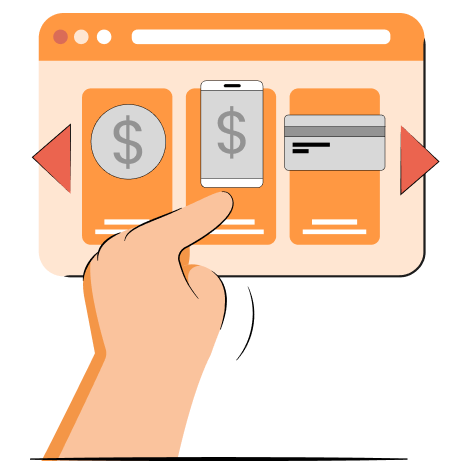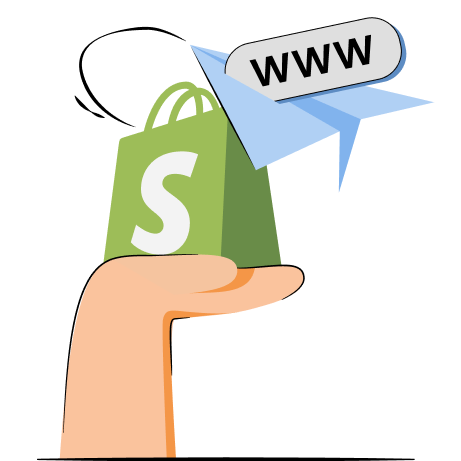There are multiple ways to sell on Shopify without inventory. You may start doing print-on-demand, dropshipping, selling digital products and services, or starting an affiliate store, among other options. The most important factor here is knowing what and how to sell online.
To start an online store without inventory, you need to accomplish several crucial steps. These involve researching the niche, analyzing your potential competitors, finding reliable suppliers or bonding with affiliate partners, and optimizing your store for SEO.
It’s essential to learn how to sell on Shopify without inventory correctly so the business kickoff would be stress-free and profitable. Therefore, we will walk you through the top no-inventory e-commerce types and examples of what you can sell without stocking.
Even with no inventory, your store needs to be fast and rank high in search
Start optimizing with TinyIMG6 business models to sell on Shopify without inventory
Selling on Shopify without having a stock of supplies can be a great way to join the e-commerce world. The best part is that you don't have to spend money on inventory or deal with shipping directly, and returns are simplified. In addition to this, the overall risk is considerably lower.
However, there are several types of no-inventory Shopify businesses. So, let’s review each of them in-depth right below:
Dropshipping
Dropshipping is a smart way to sell without inventory if you’re going for a fast but reliable result. This way, you can maintain the variety you offer to your customers, respond to their needs, and avoid financial losses.
While dropshipping, you must find a suitable and trustworthy supplier. Getting the app for Shopify dropshipping can noticeably ease the process. For example, DSers is an all-in-one solution that minimizes manual work. It selects wholesalers with a good selection of products and fast shipping, not to mention the automatically synced shipping and tracking data you receive.
When your Shopify store is set up and the first order comes up, you will simply need to order the product from the warehouse. Finally, it will be shipped right to the buyer without extra shipping hassle on your side!
As the manufacturing part of the job falls off, you have extra time to make a successful platform to continue increasing sales. It’s self-evident that high-quality images and, overall, a nice-looking store will create a positive effect on your business.
Dropshipping pros
- Low-risk eCommerce model
- No upfront investment required
- No manufacturing needed
- No shipping on your behalf
- Extra time for commercial improvement
Dropshipping cons
- There can be delays from the warehouse
- Multiple manufacturers are needed for the product variety
Print-on-demand (POD)
Print-on-demand is when you sell graphic designs that go on white-label products, such as T-shirts, bucket hats, hoodies, and more. Here, a reliable supplier is a must, as it takes care of your fabrics and customizes them for you.
Selling POD on Shopify can include your unique work only, or you can also cooperate with famous brands by obtaining a license. This way, you can make bombastic designs using movies or video game characters.
Once you have some designs prepared, all you need to do is to post them on your store and share them with your POD supplier (with a print-on-demand app). Since your POD account is synchronized with the supplier, you don’t have to worry about production or shipping.
The print-on-demand method is a splendid solution for beginning artists. It saves heaps of time for you to come up with new illustrations and improve your online store. Yet, keep in mind that having less control over your sold merchandise can also be quite frustrating. It’s inevitable to come across an inferior quality caterer that offers worse fabrics, shipping delays, or both.
POD pros
- No printing in advance
- Low financial risks
- No special manufacturing equipment needed
- Beginner-friendly eCommerce niche
- Saves extra time for developing your store
POD cons
- Little control over production
- Shipping can take longer than expected
You want to keep your design images high-quality and light at the same time. TinyIMG app can help you with that
Automatically compress images with TinyIMGSelling affiliate products
Another way to run a no-inventory online store is to start selling affiliate products. This e-commerce method allows you to sell products on your store from reliable affiliate partners without manually crafting products or searching for suppliers from third countries.
However, to get a noticeable profit, you should already have a good customer base. Not less important is to choose affiliate products that would go along with your current eCommerce strategy, as it increases the chances for a customer to find the product.
Overall, profitable affiliate marketing is based on successful linking to the affiliate page. As soon as you get approved by a reputable affiliate program, such as Amazon Associates, it’s crucial to start directing the audience to them. Affiliate links are critical to understanding your affiliate program's success; therefore, it’s essential to monitor referral links and traffic using all-round Shopify affiliate apps
Affiliate store pros
- No additional inventory is needed
- No extra spendings
- Little time investment
- A way to improve affiliate marketing skills
- Alternative revenue source
Affiliate store cons
- You can’t set your own pricing
- Little to no guarantee of income
Shopify marketplace
Creating a Shopify marketplace is a powerful way to grow your e-commerce business without having to invest in an inventory. To run a marketplace, you don’t need to build a new website, as reputable Shopify apps for marketplaces help you convert your current store into a multi-vendor platform effortlessly.
Shopify does not offer built-in functionality to turn your store into a marketplace. Therefore, selecting the right marketplace application is crucial for a successful start. The app should be able to sync product information and other important details automatically.
It’s also important to highlight the main pain points that marketplace owners must go through. That said, you must split the payment with the seller, respectfully evaluating included fees and commissions. Though you won't have to handle shipping yourself, it is essential to state shipping costs and terms explicitly on your website. Moreover, providing high-quality customer support becomes more complicated, as not every seller will be sophisticated enough to answer all burning questions.
Marketplace pros
- No need for an inventory
- Expands the customer base
- Improves store’s credibility
- Minimal expenses
- Boosts your revenue
Marketplace cons
- It may be difficult to manage customer support fluently
- The revenue is split between you and the seller
Service business
Shopify is a great place to start your career as a freelancer or enable online bookings for your currently existing services. Copywriters, business consultants, beauty salons, and other professionals can sell virtual or real-life consultations via an online store. This way, you seamlessly reach a wider but more concentrated audience base.
Starting selling your business on Shopify is easy. The platform has an intuitive built-in website builder, and you may add numerous third-party apps for managing your bookings, keeping in touch with the clients, and more. Additionally, Shopify supports multiple payment methods, so if you work remotely, you still will be able to receive your payments.
Service business pros
- Vast variety of services you can sell
- No investment in an inventory
- Good for marketing strategies
- Helps you reach more customers
- Allows you to improve your skills
Service business cons
- You must be easy to contact with
- Lack of physical character
Third-party fulfillment centers
The method is excellent for combining it with dropshipping – it allows you to order larger product volumes for better pricing. And the 3PL companies will take care of everything from warehousing to shipping.
In a nutshell, third-party logistics providers, also known as 3PLs, offer logistics and supply chain management services. Most of the time, these services include order fulfillment, inventory management, warehousing, and shipping. Overall, it allows you to sell large amounts of physical items without having to take care of an inventory manually.
What’s also great is that you don’t need to go far looking for a reliable 3PL service, as usually, they have Shopify integrations, allowing you to contact them in no time.
Third-party fulfillment centers pros
- A way to save money
- Ensures high-quality shipping procedures
- Enhances customers’ experience
- Manages inventories for you
- Opportunity to have reduced shipping costs
Cons
- You lose the control over shipping processes
- Most fulfillment centers don’t allow you to customize the packages
More ideas for a no-inventory Shopify business
There are even more ways to earn cash on Shopify without investing in a stockpile. Graphic illustrations, digital literature, fitness classes, or even mindblowing expeditions – nearly everything can become a new eCommerce idea.
To get a better image of what an inventory-free business can look like, take a look at successful Shopify examples below:
Memberships
By selling memberships on Shopify, not only that you don't need inventory, but you can also easily boost your existing business's voice. Galleries, educational institutions, sports clubs – each perfectly fits for selling online memberships. Moreover, many non-profit organizations find memberships as a way to have reliable financial support.
Consultations
Online consultations have been peaking for a couple of years now. Consequently, they have become one of the most popular things to sell on Shopify. Professionals, such as fitness coaches, doctors, marketing specialists, and others, have been successfully selling their virtual or in-person consultations through an online store.
Suggested reading
Digital downloads
Thanks to digital technologies, creative merchants can earn more easily than ever before. One of the ways is to sell your graphic illustrations, music, videos, photos, planners, various design elements, and more on Shopify through an online store.
It’s no secret that globally famous companies constantly dig through Shopify to find artists to cooperate with. Likewise, people tend to look for ways to support small businesses and beginning artists.
Suggested reading
Adventures
The world is still getting better after the pandemic catastrophe, and people are as thirsty for adventures as ever. Therefore, now is a perfect time to show your expedition or vacation planning skills. Luckily, Shopify is suitable for starting an experience-based business and selling adventures from laser tag to exotic trips to the Maldives
Tips for selling without inventory on Shopify
Here are the main aspects that lead to a successful Shopify store without an upfront inventory:
- Do thorough research. Before jumping right into the business, take some time to review your competitors, potential audience, and current trends. Remember, success comes from hard work!
- Wisely choose your partners. Whether you’re going to dropship products, print-on-demand, or work with affiliates, always thoroughly inspect your possible partners. If it’s a supplier, make sure you are aware of the quality they offer and how well the shipping process is managed. Likewise, you must look for an affiliate partner that fits your business vision.
- Complete Shopify SEO optimization. Shopify itself offers a decent SEO suite of features. However, there’s a way to improve your Shopify store rankings on the search engine even more. A thorough keyword research, optimized metadata, and images, or improved store speed are essential for taking your eCommerce to the next level.
- Get active on social media. With social media constantly blooming, getting active on it is the best way to draw more traffic to your Shopify store. There, you can easily target specific audiences and build a better connection with them without spending heaps of money.
- See what other strategies you can use to get first sales on Shopify.
You can sell nearly anything on the online Shopify store. Whether you’re short on money and can’t invest in upfront inventory or simply have genius ideas to pitch – learning how to sell on Shopify without inventory will help you reach the audience. So, make sure you follow the recommendations and put effort into your dream!

Frequently asked questions
No, you don’t need inventory to sell on the Shopify store. To earn money on Shopify, you can do dropshipping, POD, work with affiliate programs, sell digital art, and much more. This means, the Shopify store is suitable for multiple eCommerce models.
The best way to sell on Shopify without inventory depends on your vision. If you’re only looking for a way to earn money without pitching your own ideas, then dropshipping is for you. In contrast, POD is excellent if you have some clothing illustrations to sell without working with the fabrics.
The best ways to sell clothes on Shopify without inventory include dropshipping and print-on-demand business types. Both of these e-commerce methods don’t require you to manage an inventory manually. All you have to do is either look for suppliers of the products you want to sell or create designs that will be printed on demand by your selected printing service.





